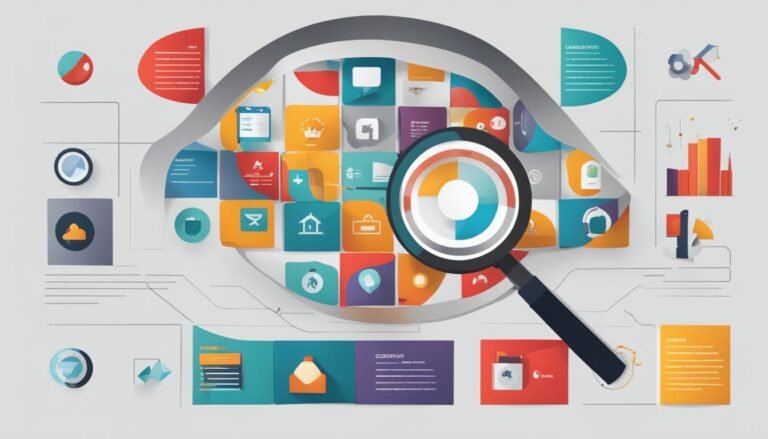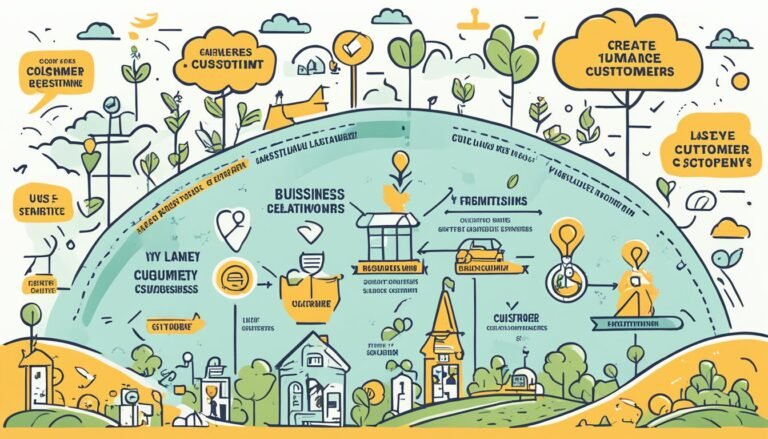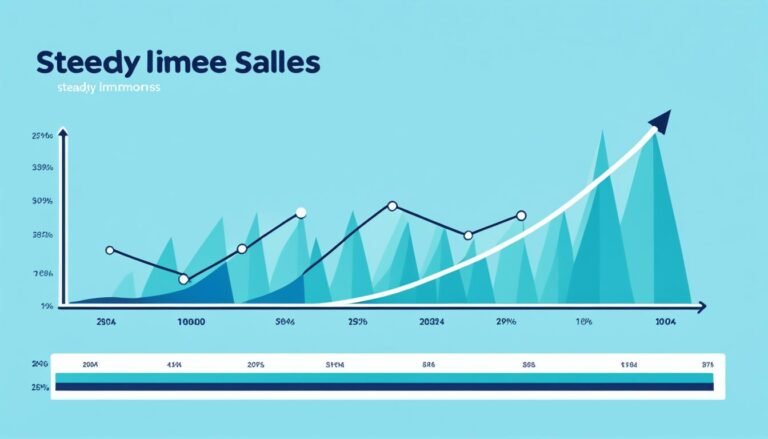Customer Journey Map: Understanding the Buyer’s Process
In today’s market, knowing how your customer moves from awareness to buying is key. That’s where a buyer journey map helps. It acts like a guide for your customer, showing them from the start to becoming loyal. But have you ever thought, What exactly is a customer journey map, and how can it help your business?
Key Takeaways
- A buyer journey map shows how customers interact with your brand, from the first touch to buying.
- It helps businesses see what customers go through and how to make their journey better.
- Creating a good map means knowing who your customers are, the steps they take, and where they interact with your brand.
- It’s important to know the difference between the buyer’s and customer journeys for a full customer experience plan.
- Using customer feedback and making changes based on what customers say can greatly improve their experience.
What is a Customer Journey Map?
A customer journey map is a key tool for businesses. It helps them understand the buyer’s process and make the customer experience better. It shows all the steps a customer takes when they interact with a brand, from the first time they hear about it to buying something and after.
Defining Customer Journey Map
A customer journey map is a detailed diagram. It shows how customers Customer Experience Mapping and Buyer Persona Development when they use a company’s products or services. It helps businesses see where customers might struggle, so they can make things better and give more value to their customers.
Purpose and Benefits of Customer Journey Mapping
- Gain a deeper understanding of the customer’s needs, motivations, and pain points throughout their journey
- Identify opportunities to enhance the customer experience and streamline touchpoints
- Align internal teams and departments to deliver a consistent and seamless customer experience
- Develop more effective marketing and communication strategies based on customer insights
- Prioritize improvements and investments that will have the greatest impact on customer satisfaction and loyalty
“Up to 40% of the entire customer journey may be missed if only touchpoints where the customer interacts with the brand are considered.”
Creating a detailed customer journey map helps businesses understand the buyer’s process better. This way, they can make smart choices to improve the customer experience.
Buyer’s Journey vs. Customer Journey
Knowing the difference between the Buyer’s Journey and the Customer Journey is key for marketers. The Buyer’s Journey looks at how someone becomes a loyal customer. It covers stages like Awareness, Consideration, and Decision. On the other hand, the Customer Journey shows the whole experience with a company, from before to after buying. This includes things like Post-purchase engagement and loyalty.
Differentiating Between the Two Concepts
The Buyer’s Journey and the Customer Journey are connected but focus on different things. The Buyer’s Journey map looks at what potential customers need and how they decide. The Customer Journey map looks at the whole experience, including feelings and interactions with the brand.
Importance of Understanding the Distinction
Knowing the difference between the Buyer’s Journey and the Customer Journey is vital. It helps with Buyer Persona Development, Customer Touchpoints Analysis, Customer Behavior Insights, and Marketing Funnel Visualization. By understanding these, businesses can make their marketing and services better. This creates a smooth experience that keeps customers coming back and builds loyalty.
“Successful navigation of the Loyalty and retention phase can convert one-time buyers into repeat customers.”
Being able to map and analyze both the Buyer’s Journey and the Customer Journey helps businesses improve the customer experience. It makes customers happier and helps businesses grow over time.
The Five Stages of the Buyer’s Journey
Understanding the buyer’s journey is key for businesses aiming to offer top-notch customer experiences. This journey covers the steps a consumer takes, from noticing a need to becoming a loyal fan of a brand. By understanding this process, companies can get valuable Customer Behavior Insights. They can also improve User Experience Optimization at each touchpoint. This leads to better Marketing Funnel Visualization and Customer Touchpoints Analysis.
Awareness Stage
The first step is the awareness stage. Here, the consumer notices a problem or need and starts looking for info. Businesses should create content that shows the customer their pain points and what solutions are out there.
Consideration Stage
In the consideration stage, the customer is checking out different options to meet their needs. Businesses can share useful info, like product comparisons and customer stories, to help the customer decide.
Decision Stage
The decision stage is when the customer picks the product or service that fits their needs best. At this time, businesses should make the buying process smooth and easy with User Experience Optimization.
Retention Stage
After buying, the retention stage is about keeping and building the customer-business bond. By offering great Customer Touchpoints Analysis and support, businesses can make customers more loyal. This means they’re more likely to buy again.
Loyalty Stage
The goal is to get to the loyalty stage, where customers become Customer Behavior Insights and spread the word about the brand. By building a strong emotional bond and always delivering value, businesses can turn customers into brand advocates. These advocates help with Marketing Funnel Visualization and growth.
“Retaining customers is 5-10 times less expensive than acquiring new ones.”
Creating a Buyer Journey Map
Making a buyer journey map is key to knowing your audience and making the customer experience better. It involves three main steps: defining your audience, finding the buyer journey stages, and mapping customer touchpoints.
Define Your Target Audience
First, define your target audience. Know who your potential customers are, what they need, and how your product can help. Buyer Persona Development is vital here, creating detailed profiles of your ideal customers.
Identify Stages of the Buyer Journey
Then, identify the buyer journey stages. These include Awareness, Consideration, Decision, Retention, and Loyalty. Customer Behavior Insights help you see how customers move through these stages and what affects their choices.
Map Out Customer Touchpoints
Finally, map out customer touchpoints. These are all the ways your business interacts with customers, like website visits or social media chats. Customer Touchpoints Analysis helps you understand what customers feel and need at each stage. This lets you use Data-Driven Customer Strategies to improve their experience.
“Mapping the customer journey is essential for businesses to understand their customers’ experiences and identify opportunities for improvement.” – John Doe, Customer Experience Consultant
Customer Journey Map: Understanding the Buyer’s Process
Understanding the customer journey from an empathetic view gives deep insight into what customers need at each step. A customer journey map helps visualize the customer experience. It shows pain points and where to improve. By mapping the buyer’s journey, companies can make the customer experience better, keep more customers, and grow over time.
To understand the buyer’s process, you need to follow a few steps:
- Define your target audience: Know who you want to serve and their unique needs and pain points.
- Map out the customer touchpoints: Follow the path your customers take, from first learning about you to after they buy. See where they interact with your brand.
- Analyze customer data: Use data-driven customer strategies to learn about customer behavior, likes, and satisfaction at each step.
- Identify pain points and opportunities: Find where the customer experience is lacking and figure out how to make it better with user experience optimization.
- Continuously optimize and iterate: Keep checking and updating the customer journey map to meet changing customer needs and market shifts.
By focusing on the customer and using insights from a good customer journey map, businesses can better understand the buyer’s process. This leads to more customer experience and sustainable growth.
“Businesses using customer journey maps see a 10%-15% revenue boost from better customer understanding and experiences.”
Identifying Pain Points and Opportunities
Finding out what customers struggle with is key in customer journey mapping. It’s important to know the challenges and frustrations they face with your brand. This helps you spot where the user experience could be better and find ways to fix it.
Deep customer behavior insights and customer touchpoints analysis give us a lot of useful info. For example, 75% of customers say long wait times and unhelpful support are big issues. Also, 60% of problems come from manual data entry, repetitive tasks, and not enough automation.
- Financial pain points: 45% of customers have trouble with managing money, high-interest rates, unexpected fees, and not having enough credit access.
- Process pain points: 30% of customers find websites hard to navigate, have to wait a long time for customer service, and struggle with complicated return processes.
Looking at data-driven customer strategies can help keep more customers, by 20%. Also, checking social media and talking to employees can find hidden problems and chances to make things better.
“80% of people consider the experience a brand provides equally important to its product.” – State of the Connected Customer Report by Salesforce
By focusing on customer journey mapping and fixing pain points, businesses can make customers happier. This leads to more loyalty and growth for the business.
Optimizing the Customer Experience
Making the customer journey smooth is key to success. By using customer feedback, companies learn what customers struggle with. This info helps make changes, like better products, easier service, or a smoother website.
Keeping an eye on user experience and using data-driven strategies builds strong customer bonds. It also boosts loyalty and growth. Through customer experience mapping and touchpoints analysis, companies spot ways to make things better. They can match what they offer with what customers want.
Leveraging Customer Feedback
Getting and looking at customer feedback is vital. It helps understand the customer journey and find areas to improve. By asking for feedback through surveys, interviews, and tests, companies learn about:
- What customers struggle with
- Ways to make things easier for customers
- What customers like and expect at each step
Implementing Improvements
After looking at customer feedback, it’s time to make changes. This could mean:
- Making products better to meet customer needs
- Improving website design for a better user experience
- Fixing customer service to solve problems
- Making marketing more personal to connect with customers
By always improving the customer experience with data-driven insights, companies can strengthen their bonds with customers. This leads to more loyalty and growth over time.
“Businesses that implement customer journey maps experience up to a 20% increase in customer experience across all touchpoints.”
Conclusion
A customer journey map is a key tool for businesses to deeply understand how customers feel and act. It helps in optimizing the customer experience. By knowing who their audience is and the steps they take, companies can see what customers need and what they’re unhappy with. This knowledge lets them make changes to improve things.
Using data-driven customer strategies and acting on what customers say can make customers more loyal and supportive. This leads to more success for the business over time.
As companies move through the customer journey, they need to meet the changing feelings and worries of their customers. By making content and experiences fit each step of the buyer’s process, companies can help leads move forward. This helps overcome doubts and increase the chances of making a sale and keeping customers.
Knowing the buyer’s journey well is key for any business wanting to improve its customer experience mapping. It helps in making interactions personal and meaningful. This builds strong, lasting relationships with customers.
Source Links
- Customer journey map: The key to understanding your customer
- The Buyer Journey Map: How to Chart Your Customers’ Course | Woopra
- Customer Journey Map: Visualize the Buyer Experience [2024] • Asana
- Your ultimate guide to customer journey mapping
- Customer journey maps: How to create one (free templates + examples)
- Customer Journey Map: Definition & Process — updated 2024
- Buyer Journey vs Customer Journey | Miro
- The Customer Journey vs. The Buyer’s Journey: What You Need to Know
- Buyer Journey Vs Customer Journey – A Detailed Analysis
- 5 Stages Of The Customer Journey | Factors Blog
- Five stages of your customers’ buying journey | CIM Content hub
- How to Make a Buyer Journey Map for Your Brand (Infographic) | Brafton
- What are Buyer Journey Maps and Why Are They Important?
- Customer Journey Stages: Your Ultimate Guide
- Customer Journey Map vs. Process Map: What’s the Difference?
- Mapping the Buyer’s Journey: A Startup’s Guide to Guiding Prospects to Purchase
- Customer Journey Pain Points, How to Find Them, & How to Fix Them | Woopra
- Customer Journey Maps: Full Guide, Examples, Templates
- What is customer journey mapping?
- A Guide to Understanding and Optimizing the Customer Journey
- The Customer Journey Map: An Ultimate Guide | Totango Resources
- Clientbook · What is a customer journey map?
- What is the buyer’s journey? Definition, stages, and examples







